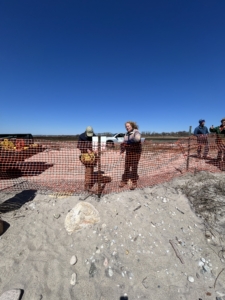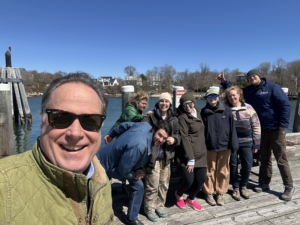Doug Tallamy is no stranger to Fishers Island. A longtime supporter of our mission, he has visited the island multiple times, leading tours of the Parade Grounds and inspiring residents to rethink how their landscapes can support the natural world. His message is simple but transformative: what we plant directly shapes the health of our ecosystems!
In a recent New York Times article, Tallamy outlines four ecological goals every landscape should aim to fulfill:
These four principles are central to the work we are doing through habitat restoration, native plant demonstration gardens, invasive species removal, and community education. Like Tallamy, we believe that every yard and every effort counts.
Tallamy encourages small, achievable steps, such as planting keystone native species like oaks or goldenrod, replacing invasive plants, and rethinking the role of lawn in residential landscapes. These changes can transform private properties into powerful tools for conservation.
Whether you’re maintaining a home garden or caring for larger green spaces, this article is a valuable resource for anyone looking to align their landscape with nature!
Read the full article: The Four Ecologically Crucial Things You Should Do in Your Garden (NYT)
April 9, 2025
Article written by Margaret Roach
Feature photo by Rob Cardillo for The New York Times
2025 Spring Migratory Bird Count Results
Current Events, Events, Feature, News2025 Spring Migratory Bird Count
Current Events, Events, NewsPhoto by Anna White
Spring Migratory Bird Count 2025
When: Sunday, May 11th at 8:00 am
Where: Meet outside of the Community Center
We invite you to join us for our annual Spring Migratory Bird Count on Sunday, May 11th. This seasonal tradition offers a great opportunity to observe birds returning to their northern breeding grounds while exploring a variety of habitats across the island.
The morning will begin outside the Fishers Island Community Center at 8 am, where we will gather before setting out in groups. Guided by Dr. Adam Mitchell of Tarleton State University, along with birding experts Emily Baisden and Will Almeida, the group will visit 15 designated stops from the West End to the East End of the island. Each stop lasts five minutes, following established Audubon count methods, as we identify and record bird species seen and heard along the way.
All are welcome to attend. No prior birding experience is needed. If you have binoculars, we encourage you to bring them. A limited number will also be available to borrow. Please wear comfortable walking shoes and dress for the weather.
This annual count supports the Conservancy’s long-term efforts to monitor bird populations and contributes valuable information to regional conservation work.
Right Place Right Plant: Native Plants and Practical Uses
Current Events, Events, Feature, NewsA Gift to the Island- Aldo Benches from FI Students
Events, Feature, NewsThese benches were built in honor of Aldo Leopold, a pioneering conservationist whose work continues to inspire people to connect with nature and care for the land. His classic bench design invites quiet observation and a deeper appreciation of the natural world.
One bench can be found in the Museum Sanctuary and the other is placed at the Parade Grounds, where it offers a front row seat to the island’s birdlife and open space.
A huge thank you to the students who made this project possible: Kris, Jacob, Theo, Connor, Kyle, Lil, Kyzen, Madelyn, Antonio, and Cyllus. Your craftsmanship and care have added something truly special to these spaces.
If you find yourself nearby, take a seat and enjoy all that nature has to offer on Fishers Island.
Earth Day 2025 Recap
Events, Feature, NewsA Strong Start to Shorebird Season
Events, Feature, NewsThis past wednesday, FI Conservancy hosted our first Shorebird Pre-Fencing Day to prepare for the return of the endangered Piping Plover and the threatened Least Tern. These small shorebirds nest directly on open sand, which leaves their eggs and chicks highly vulnerable to disturbance. Symbolic fencing helps reduce these risks by clearly marking nesting areas to keep people and pets at a safe distance.
nesting areas to keep people and pets at a safe distance.
Fencing was successfully installed at three key sites across the island: Eighth Hole Beach, South Beach, and Airfield Beach. Visitors are now reminded that dogs must be leashed to avoid disrupting or damaging nesting sites. The fencing will remain in place through the shorebird breeding season but will be removed later in the summer once nesting is complete.
breeding season but will be removed later in the summer once nesting is complete.
We are grateful to the volunteers and partners who joined us for this effort. Thank you to Michele, Nate Chaves, Jessica NeJame from the Henry L. Ferguson Museum, Kristen Peterson, Stephanie Hall, and FIC President Tom Sargent. Special thanks to Sophia Brown and Sean Wiedemann from the New York State Department of Environmental Conservation, whose guidance was essential as we relaunch the Long Island Colonial Waterbird Survey efforts on Fishers Island.
Protecting shorebirds is a community effort. Thank you to everyone who came out to support this important work. Together we are helping safeguard Fishers Island’s shoreline and the wildlife that depends on it.
Must-Read Article: Doug Tallamy on the Four Things Every Garden Should Do
Feature, NewsDoug Tallamy is no stranger to Fishers Island. A longtime supporter of our mission, he has visited the island multiple times, leading tours of the Parade Grounds and inspiring residents to rethink how their landscapes can support the natural world. His message is simple but transformative: what we plant directly shapes the health of our ecosystems!
In a recent New York Times article, Tallamy outlines four ecological goals every landscape should aim to fulfill:
Manage the watershed
Support pollinators
Bolster a viable food web
Sequester carbon
These four principles are central to the work we are doing through habitat restoration, native plant demonstration gardens, invasive species removal, and community education. Like Tallamy, we believe that every yard and every effort counts.
Tallamy encourages small, achievable steps, such as planting keystone native species like oaks or goldenrod, replacing invasive plants, and rethinking the role of lawn in residential landscapes. These changes can transform private properties into powerful tools for conservation.
Whether you’re maintaining a home garden or caring for larger green spaces, this article is a valuable resource for anyone looking to align their landscape with nature!
Read the full article: The Four Ecologically Crucial Things You Should Do in Your Garden (NYT)
April 9, 2025
Article written by Margaret Roach
Feature photo by Rob Cardillo for The New York Times
Pitch In for the Planet- Earth Day 04/19
NewsIn honor of Earth Day, the Fishers Island Conservancy and the H.L. Ferguson Museum and Land Trust invite all visitors to join an afternoonof conservation work and community connection.
an afternoonof conservation work and community connection.
Participants will meet at the Museum at 2:00 PM to receive assignments before heading out to South Beach, the Parade Grounds, and nearby trails for beach cleanup and invasive plant removal.
Volunteers are encouraged to bring any tools they are comfortable using, such as clippers or loppers. No chainsaws, please. Extra tools will be available. Long pants, long sleeves, socks, and gloves are strongly recommended for protection against thorns and poison ivy.
Following the cleanup, light refreshments will be served at the Museum. A simple craft activity will also be available for those who would like to participate. Race Rock Garden Co. is providing seed pots and soil, and the Conservancy will contribute native seeds along with small seed packets remaining from past Nature Days.
We hope you’ll join us in caring for the land and celebrating Earth Day as a community.
Shorebird Pre-Fencing Day – 04/09
Current Events, Events, Feature, NewsSign being installed on symbolic fencing by Anna White
As our tiniest visitor, the endangered Piping Plover, returns to Fishers Island’s shores this spring, the Fishers Island Conservancy is preparing to install symbolic fencing at known nesting sites. These small shorebirds lay their eggs directly on open sand, making them extremely vulnerable to disturbance. To protect them and give them the best chance at a successful breeding season, FIC will kick off the season with Pre-Fencing Day on Wednesday, April 9.
Symbolic fencing is a simple yet critical step that helps reduce disturbance from people and pets by clearly marking sensitive nesting areas. This protection is not just for Piping Plovers but also serves as nesting habitat for Least Terns, which are listed as threatened in New York State. These birds depend on undisturbed beach habitat to successfully nest and raise their young.
This work is part of the Long Island Colonial Waterbird Survey (LICWS), a statewide monitoring and protection program coordinated by the New York State Department of Environmental Conservation. We are excited to partner with Sophia Brown from NYSDEC as we relaunch LICWS efforts on the island. Fishers Island falls within Region 1 of the NYSDEC, which includes Suffolk County and nearby coastal islands.
We invite anyone interested in helping to join us on Wednesday, April 9th at 10:30 AM outside the FI Community Center. We encourage volunteers to bring work gloves and dress for the weather.
Come lend a hand and help us protect our islands shoreline and the shorebirds that call it home!
Must-Read Article: Alarming Trends in Bird Populations
Feature, NewsCheck this out—the Cornell Lab of Ornithology has released a powerful new report showing that bird populations across the U.S. are continuing to decline. One-third of species are now considered high or moderate concern, and the losses are especially steep for grassland and forest birds.
Here on island, we are working hard to monitor and protect local bird populations through seasonal surveys, habitat restoration, and long-term conservation planning. Our island plays a key role in the Atlantic Flyway, providing critical stopover and nesting habitat for both migratory and resident birds.
Protecting birds means protecting the health of our entire ecosystem. We encourage everyone in the community to take a moment to read this important article and stay connected to the bigger picture.
Read the full article from the Cornell Chronicle here -> State of America’s birds: Population declines continue